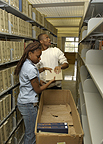September 15, 2005
Morris Library's 2.5 million-volume collection Big move means focusing on smallest details
CARBONDALE, Ill. -- Anyone with experience in packing up a house and moving box after box of books would shudder at the idea of moving the 2.5 million-volume collection out of Southern Illinois University Carbondale's Morris Library.Anyone except Bill and Trudy Menard, the husband-wife team supervising the relocation of all those books and documents to make way for the massive expansion and renovation of the library. The packing and moving of the collection to the one-story, 50,000-square-foot McLafferty Annex started this week, and will take six to eight weeks to complete.
The Menards work for Hallett Movers of suburban Chicago, a firm specializing in moving large libraries. With between 40 and 50 campus library moves under their belts, the Menards know exactly what needs to be done.
"The biggest factor is getting the collection back in order," said Bill Hallett, co-owner of the moving company with his brother Jack. "Books that are now on the fourth floor need to be integrated with books on the second floor. And at the other end of the move, everything has to end up on one floor."
His firm has plenty of experience. They've moved the 3 million-volume Seattle Public Library, the 3 million-volume Minneapolis Public Library in January, the University of Chicago's Regenstein Library, the 1 million-volume Florida International Library and the Country Music Hall of Fame in Nashville, Tenn., among many others.
Central to the effort are attention to detail and proper handling of the collection.
"Libraries get so overcrowded that they store books in several locations," Hallett said. "That is the real nightmare, reintegrating books from several places into one location. Caring for and protecting the collection is a primary concern."
That means plenty of advance planning. The Menards set up camp two weeks ago on Morris Library's third floor to begin final preparations. Lists of the collection and diagrams of the library and the annex cover the top of a table. To these veterans of Dewey collections, special collections, periodicals and all the rest of the treasures found in a library, it's merely a matter of organization.
"There's no room for mistakes, space-wise and organization-wise," Menard said.
No small undertaking when you're talking about 48,000 shelves of materials and elements of the collection that are split among several floors. The Menards' attention to detail meant tagging the entire collection, using numerical and color-coded tags in Morris that correspond to tags already in place on shelves in the annex. They are exacting in their measurements, down to the number of inches of books coming off the library's shelves that must fit on compact shelving in the annex.
The company trucked in 250 "missiles" – the flat dollies on which workers transport the boxes of books within the building. By Monday, the first day of the move, Menard was calling for 250 more.
Along with several other supervisors from Hallett, the Menards are overseeing between 15 and 20 SIUC students hired to assist with the move. They carefully pack the books into the boxes, which they then roll on the "missiles" to the library loading dock. Workers from SIUC's physical plant load the boxes onto University trucks, which transport them to the McLafferty Annex. There, physical plant workers unload the trucks at a central staging area, and the moving company's supervisors and the students place them back in proper order on the compact shelving.
As he watched the seemingly endless stream of boxes make their way to the library loading dock, Library Affairs Dean David H. Carlson called the first day of the move "a real bellwether day." But Carlson and his staff know there's a long way to go in this endeavor. The $42 million project, the largest capital project in the University's history, will take another three years.
Once an entire floor is empty, workers can begin the extensive renovations. Officials hope construction will begin in January on the 50,000-square-foot addition. Plans also call for replacement of Morris' entire exterior façade, along with the aging heating-ventilating-air conditioning systems, parts of which are 50 years old.
During the first phase of the project, the basement and most of the first floor of the library will remain open. Floors 2 through 7 closed in August for renovation, and the south entrance to the library – closest to Thompson Woods – closed this week. Upon completion of the expansion and renovation of the rest of the library, most of the staff and collections will return and work will begin on the basement and first floor.
The Library Affairs staff is doing its utmost to minimize the inconvenience to library patrons. A retrieval system is in place, with the library promising to have materials requested transported from the annex and available at the Morris circulation desk in two hours. Materials will remain on hold for two days.
Once the collection is in place at the annex, probably in mid-November, the annex will be open to the public. Hours will be 9 a.m. to 5 p.m. Monday through Friday, and there will be tables, chairs and 10 computers available. Patrons will be able to check materials out of the annex.
Enhancing Morris Library and SIUC's knowledge resources are among the goals of Southern at 150: Building Excellence Through Commitment, the blueprint for the development of the University by the time it celebrates its 150th anniversary in 2019.
(Caption: Clearing the shelves – Dominique Winston (front), majoring in English at Southern Illinois University Carbondale, and Carvell Talley, a journalism major, are among the students hired by Hallett Movers of suburban Chicago to help clear out Morris Library. Once the 2.5 million-volume collection is moved to temporary storage, the library will undergo extensive renovation and construction of a 50,000-square-foot addition. Winston and Talley are from Chicago.)
Photo by Steve Buhman

